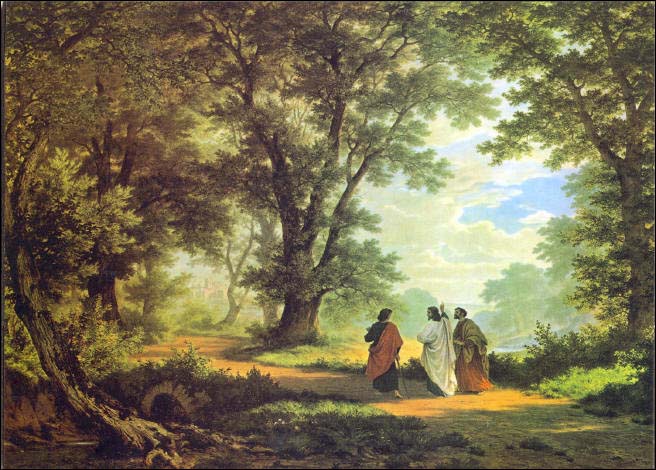In the Nicene Creed we find the phrase, “[Jesus] suffered death and was buried, and rose again . . . in accordance with the Scriptures.” These words of the creed echo a statement from Saint Paul: “that Christ died for our sins in accordance with the Scriptures, that he was buried, that he was raised on the third day in accordance with the Scriptures, ”[1] The words of Jesus in the Gospel for today confirm Saint Paul’s insight:
Was it not necessary that the Christ should suffer these things and enter into his glory?” 27 And beginning with Moses and all the prophets, he interpreted to them in all the scriptures the things concerning himself.[2]
Such texts, and they could be multiplied, are commonplace throughout the New Testament in its abundant use of the Old Testament. The general principle was enunciated by Jesus when he read a passage from the Prophet Isaiah in the synagogue at Nazareth: “Today this Scripture has been fulfilled in your hearing.”[3] And yet, when we turn to the pages of the Old Testament, we find nothing explicit about the Messiah’s dying and rising again, despite the fact that the liturgy invoked the Prophet Hosea for evidence of the resurrection: “After two days he will revive us; on the third day he will raise us up.”[4] Read literally, however, the text exhibits the prophet’s confidence that God will quickly restore the fortunes of Israel. Another text, similarly employed by Saint Peter, is in fact a prayer to be kept alive, not to be brought back from the dead: “For thou wilt not abandon my soul to Hades, nor let thy Holy One see corruption.”[5]
And yet we know that the Old Testament does prophesy the coming of Christ and his saving acts. The mode of prophecy, therefore, must be different from a blueprint or a set of instructions for assembling a Lego toy. How then are we to regard the Old Testament? We begin by looking for a pattern, for certain characteristics of God’s style (if one may use such a word) in his interventions in history. For instance, consider the text of Hosea cited above. It refers both to the past and to the present, and as such it points to the future, for what God has done once, he can do again.
The past event is the Exodus from slavery in Egypt; the current event is a return from exile; but a future event is also implied because in the Bible, every event is a promise. The Lord’s bringing of Israel out of slavery in Egypt reveals what sort of God he is: one who cares for his people. Hence, centuries later Hosea can speak with confidence of a new liberation, this time from exile. On the basis of these two, we confidently look for God to intervene again, freeing mankind from another kind of slavery—man’s servitude to sin—and effecting return from another sort of exile—from being out of his favour. We see, then, that the passage from Hosea really does refer to the Messiah. Moses himself makes the point when he sees that his own vocation is a pledge on the part of God that there will be in the future a new Moses: “[God said to Moses,] ‘I will raise up for [the people] a prophet like you from among their brethren.”[6]
What has been said provides a method by which we can discern the death and resurrection of Jesus in “Moses and all the prophets,” and indeed in “all the Scriptures.”[7] Consider the following list, each item of which instances a real or symbolic death and resurrection:
- the birth of Seth, whom Adam and Eve received as a replacement for Abel.
- the great flood and safety through the ark of Noah
- the birth, and particularly the sacrifice of Isaac
- the whole history of the Judges, with its repeated pattern of infidelity, destruction and restoration of the nation through the action of a divinely appointed leader
- the passage through the Red Sea
- Nathan’s prophecy that Davie would have a successor whose kingdom would last forever
- the sickness and cure of Hezekiah
- the theory of the remnant
- the destruction and restoration of Jerusalem, and of the temple
- the dry bones of Ezechiel
- the suffering servant of Isaiah and the corresponding Psalms
- “the sign of Jonah”
- Daniel in the lions’ den
- Esther as saviour of the people
- the stone, rejected, that has become the corner stone (Ps 117/118)[8]
The thing to remember is that the history of salvation is a story, in which anything can happen, rather than a series of repeatable actions and reactions such as you would find in a science laboratory. We are all actors in the story, for just as the history of Jesus was told in type, prefigured in the history of Israel, so our story is “predicted” (so to speak) in the history of Jesus. It follows that Saint Paul could tell the Christians of Galatia—and so also tell us—that they were—as are we—“the Israel of God”;[9] that is why he could say, “It is men of faith who are sons of Abraham.”[10] The basis of such statements, and of this approach to the Bible, is the fact that it speaks to everyone, always and everywhere. Consequently, penetrating the mystery of God’s action is more a sensitivity to symbol than an application of logic. As such it demands a new way of looking at things, that is to say, a conversion: “Those who say ‘I know him’ but do not keep his commandments are liars.”[11] But this statement opens a topic for another discourse, and as such it may be put aside for later treatment.
[1] 1 Cor 15.3-4.
[2] Lk 24.26-27.
[3] Lk 4.21.
[4] Hosea 6.2.
[5] Act 2.27.
[6] Deut 18.18.
[7] This statement reminds us that for the apostolic Church the Bible consisted of the Jewish Scriptures, what we call the Old Testament.
[8] This list comes from Yves M.J. Congar, OP, Tradition and Traditions (London: Macmillan, 1967), p. 72.
[9] Gal 6.16.
[10] Gal 3.7.
[11] 1 Jn 2.4.











